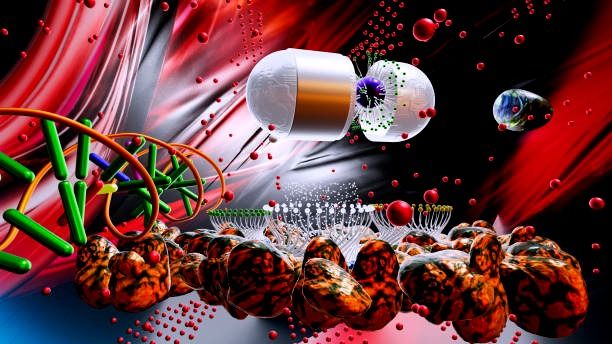Nano-medicine: The future of targeted therapy
1. What is nanomedicine?
Nanomedicines are drugs or drug delivery systems made using nanotechnology, which work at the nanometer scale (1-100 nanometers). This technology delivers drugs to specific cells or tissues, which is known as targeted therapy. Nanomedicines are being used in the treatment of cancer, diabetes, heart disease, and infectious diseases. Examples of nanoparticles are liposomes, dendrimers, polymeric nanoparticles, and metallic nanoparticles. They carry drugs to specific parts of the body and ensure controlled release.
2. How do nano-medicines work?
The mechanism of action of nano-medicine is as follows:
2.1. Targeting Mechanism
Nanoparticles are specifically designed to reach diseased cells or tissues. This works in two ways:
- Passive targeting : Areas like tumors have large blood vessel gaps, where nanoparticles can easily penetrate.
- Active targeting : Ligands or antibodies are added to the surface of nanoparticles, which match specific cell receptors.
2.2. Drug delivery
Nanoparticles encapsulate drugs, deliver them into the body, and release them in a controlled manner at specific sites. This reduces drug wastage and increases efficacy.
2.3. Diagnosis and Therapy (Theranostics)
Some nanomedicines combine diagnosis and treatment. For example, nanoparticles can contain imaging agents and drugs, which can be used to both detect and treat tumors.
2.4. Biocompatibility
The nanoparticles are made of biocompatible materials, which do not cause reactions in the body and are excreted over time.
3. Benefits of nano-medicines
Some notable benefits of nano-medicines:
- Targeted delivery : The drug reaches diseased cells directly, which reduces damage to healthy cells.
- Reduced side effects : Side effects are significantly fewer than traditional treatments.
- Improved efficacy : Controlled drug release increases the effectiveness of the drug.
- Treatment of complex diseases : Nano-medicine is effective in diseases like cancer, Alzheimer's, and HIV.
- Personalized medicine : Nano-medicines can be designed according to the patient's specific condition.
- Diagnostic benefits : Diagnosis and treatment can be completed simultaneously.
4. Application of nano-medicines
Nano-medicines are being used in various fields:
- Cancer treatment : Doxil (liposomal doxorubicin) and Abraxane (paclitaxel nanoparticles) are used in cancer treatment.
- Infectious diseases : Nanoparticles carry antibiotic or antiviral drugs to destroy bacteria or viruses.
- Neurological disorders : Nano-drugs are used to treat Alzheimer's or Parkinson's by crossing the blood-brain barrier.
- Cardiovascular disease : Nanoparticles are helpful in removing blockages or repairing heart tissue.
- Imaging and Diagnosis : Nanoparticles are used as contrast agents for MRI or fluorescence imaging.

Picture: istockphoto.com
5. The challenge of nanomedicine
While the potential of nanomedicine is huge, there are some challenges:
- Toxicity : Some nanoparticles can cause toxic reactions in the body.
- Re